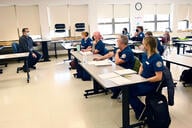You have /5 articles left.
Sign up for a free account or log in.
It's a no-brainer that the more advising colleges offer, the more engaged students will be in their education.
But a new report from the Center for Community College Student Engagement shows that effective advising may have a larger impact on returning students and thus colleges' persistence and graduation rates.
The report highlights that 78 percent of returning students reported meeting with an adviser, compared to 62 percent of entering students. According to CCCSE, that detail is significant because less than 50 percent of first-time-in-college students return to the same institution the following fall, indicating that early advising leads to increases in retention.
"Clearly advising is not the same for all students," said Evelyn Waiwaiole, executive director of the center. "But when advisers are spending more time talking with students about developing an academic plan, their career ambitions and opportunities for employment -- this is where community colleges are seeing greater student engagement."
The report found more engagement among students who had longer advising sessions, met with their adviser more often and had an adviser who helped them develop academic and career plans.
The community college survey measures engagement using five different types of student behavior benchmarks -- active and collaborative learning, student effort, academic challenge, student-faculty interaction, and support for learners. The better students respond in each of those areas, the more they were determined to be engaged learners. The data in the report are based on survey responses from more than 90,000 returning students at nearly 200 institutions and 40,000 first-term students at nearly 100 colleges.
In 2016, the Community College of Philadelphia started a new advising model that led to a fall-to-fall increase in the college's persistence rate with first-time-in-college students -- from 45 percent in 2015 to 51 percent in 2016. The year-over-year persistence rate increased for students who were assigned an adviser, as well -- from 70 percent in 2016 to 75 percent in 2017.
The college's new advising model shifted from using part-time faculty advisers to hiring nine (and soon to be 10) full-time advisers who are assigned to students.
"We moved toward the guided pathways model and I feel strongly that in order for that to work you need advisers working on particular structures to ensure students have a guidepost and a clear sense of where they're going," said Donald Generals, president of the Philadelphia college, adding that the college didn't use new dollars to hire the advisers but shifted money from vacant positions. He declined to disclose how much the shift cost.
"We did look at it as an investment," he said. "We think that when students stay, not only are they more likely to succeed, but the investment comes when they do stay long enough to complete."
The report also found that returning students who met with an adviser for more than 30 minutes showed more engagement than those who spent less time with an adviser, although initial advising sessions for nearly half of the students surveyed ranged from 16 to 30 minutes.
New students at Cleveland State Community College, in Tennessee, get at least an hour of advising, and all credited students must attend an advising session every semester. Since making those changes and others to how the college offers advising in 2013, Cleveland State has seen increases in its graduation rate.
The college's three-year graduation rate increased from 14 percent in 2010 to 22 percent in 2013. The number of full-time students, or those earning at least 24 credits in the first year, also increased from 10 percent in 2012 to 30 percent in 2016.
"The mandatory advising has helped students," said Michele Wollert, coordinator of academic advising and transfer articulation at Cleveland State, adding that the college relies on faculty members to also work as advisers and that they're assigned to students based on what they teach and the students' majors. "Before you had students signing up for classes that were not part of their program, but if they're able to talk to an adviser before registering each time, that helps."
Students also saw a difference between those who talked to them about their academic goals and those who helped them develop an academic plan, with about 86 percent of returning students reporting the former and 65 percent reporting the latter. And only 39 percent reported that an adviser discussed regional employment opportunities with them based on their career interests.
Nearly 65 percent of students reported that their adviser did not discuss when their next advising session would take place.
Tonjua Williams, the president at St. Petersburg College, in Florida, said her institution changed from a standard approach that treats all students the same to one that recognizes that students have different personal and academic situations and arrive at college with different levels of preparedness.
"We realized our students needed to be engaged and our advisers had to transition from being transactional to being more relational and getting to know the student," she said, adding that the college hired more advisers.
Despite Hurricane Irma hitting Florida last year, the college saw 500 fewer withdrawals in the fall semester, which Williams partially attributes to advisers and instructors staying engaged with students.
The report also highlighted one group of students who seemed to have a significantly better advising experience than other students: athletes.
For instance, among returning students, 67 percent of athletes said they were required to see an adviser before registering for classes, compared to 54 percent of nonathletes. Sixty-nine percent of athletes reported meeting with the same adviser multiple times during a term, compared to 55 percent of nonathletes.
The attention paid to athletes could serve as a model for how colleges can improve advising for all students, Waiwaiole said.
"It may be cost prohibitive to scale up a comprehensive advising model that currently is used for only a small group of students," she said. "But colleges can evaluate their processes for small-scale in-depth advising and consider which aspects of the model might be used for all students."




